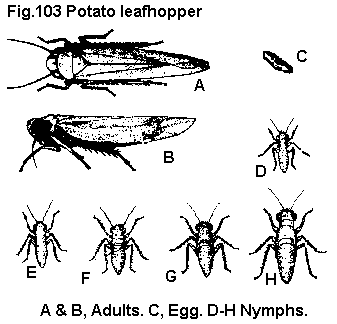Potato Leafhopper
Potato leafhopper (Figure 103), Empoasca fabae (Harris), Cicadellidae, HOMOPTERA
DESCRIPTION
Adults
Adult potato leafhoppers are usually yellowish or pale green. They exhibit much color variation, often leading to misidentification. The head of the adult often has pale or dark green spots, and six or more pale (white) spots can be found on the back immediately behind the head. Wings are held rooflike over the abdomen.. Adults are about 3.5 mm long and wedge-shaped, tapering to the rear.
Egg
The eggs are white to pale white, slender, elongate, and about 0.9 mm long.
Nymph
Nymphs are similar in shape to the adults but are smaller and lack wings. There are five nymphal instars.
BIOLOGY
Distribution
Although found throughout much of the United States east of the Rocky Mountains, the potato leafhopper only overwinters along the Gulf Coast. The insect undergoes mass movements northward in the spring and early summer and becomes established in many areas of the country. The potato leafhopper is generally distributed northward by wind. Although the potato leafhopper does not overwinter in northern areas, it may complete several generations in these areas.
Host Plants
The potato leafhopper feeds on a variety of plant species and has been reported to feed on nearly 200 kinds of plants. Flowers attacked by the potato leafhopper include dahlia, rose, and sunflower. Ornamental trees that are hosts for this leafhopper are Chinese chestnut, elm, English walnut, flowering Japanese cherry, hickory, locust, oak, and redbud. Flowering fruit trees, e.g., crabapple, also have been reported as hosts of potato leafhopper. A few of the economic plants that are infested with this insect are alfalfa, apple, eggplant, peanut, potato, soybean, and sweet potato.
Damage
Feeding and egg laying cause damage, e.g., curling, stunting, and dwarfing, to the infested plant. The leaves turn yellow, or sometimes pink or purple, and become wilted or stunted. Later, the leaf becomes brown and dies.
Larger nymphs cause most of the damage. The injection of saliva into the phloem during feeding by potato leafhoppers may cause disease-like symptoms. Infested plants may exhibit a condition known as "hopperburn" in which there is a distortion of the leaf veins, a subsequent yellowing of tissue around the margin and tip of the leaf, and eventually a rolling and curling inward of the leaf. Floral development may be reduced or obstructed completely.
Life History
When dispersing northward, populations of potato leafhopper increase on young oak and hickory foliage and then attack other plant species. Potato leafhoppers usually are first found in North Carolina about mid-May. Eggs are deposited in the midrib or larger veins of the leaves, or in the petioles or stems, and hatch in about 10 days. The five nymphal instars require about 2 weeks to develop into adults.
Adults live about one month, but have been recorded as living as long as 120 days. Females mate within 2 days after their final molt and begin laying eggs about 6 days afterwards. An entire life cycle can be completed in about 4 weeks, and as many as six generations may occur each year. Jumping or flying when disturbed, these insects are active and can run as quickly sideways or backwards as they can forwards.
CONTROL
Infestation by potato leafhopper in a greenhouse can be reduced by adequate screening of window and open areas, as well as proper sealing of door edges. Chemical insecticides provide adequate control of potato leafhopper. Contact your local county Extension personnel for a listing of chemical insecticides available for control of potato leafhopper.
Publication date: Jan. 1, 1994
AG-136
Other Publications in Insect and Related Pests of Flowers and Foliage Plants
- Aphids Found on Flowers and Foliage
- Beetles Found on Flowers and Foliage
- Bugs Found on Flowers and Foliage
- Caterpillars Found on Flowers and Foliage
- Flies and Maggots Found on Flowers and Foliage
- Leafhoppers Found on Flowers and Foliage
- Mealybugs Found on Flowers and Foliage
- Mites Found on Flowers and Foliage
- Scale Insects Found on Flowers and Foliage
- Slugs and Snails Found on Flowers and Foliage
- Thrips Found on Flowers and Foliage
- Whiteflies Found on Flowers and Foliage
N.C. Cooperative Extension prohibits discrimination and harassment regardless of age, color, disability, family and marital status, gender identity, national origin, political beliefs, race, religion, sex (including pregnancy), sexual orientation and veteran status.

